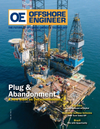
Page 29: of Offshore Engineer Magazine (Sep/Oct 2019)
Big Data and Digitalization
Read this page in Pdf, Flash or Html5 edition of Sep/Oct 2019 Offshore Engineer Magazine
BY JENNIFER PALLANICH ompanies successful in reducing sponsible for advances in AI.
their capex and opex costs in the “AI can’t do 100% of someone’s job. real world often do so by taking What AI can do, generally speaking, is the
Cadvantage of the digital world. more routine, more mundane and more pre-
There’s a reason terms like big data, dictable,” Bodnyk says. “AI is not good with digitalization, arti? cial intelligence (AI), context, causal relationships or cognition.” machine learning and the digital oil? eld Yet.
dominate conversations about technol- Within the next 25 years, AI will prob- ogy and business plans. But what do these ably be able to do more than half of what terms actually mean? How can companies humans can do, and handle more than mitigate the cybersecurity risks they face? three-quarters of it in the next 50, he says.
And how, exactly, can these technologies “Creativity is one of the last bastions of bene? t the oil and gas industry? human-only traditional intelligence,” he
Vendors, doubling down on digital, are says. “AI gives people the ability to follow offering a plethora of solutions in ? elds their dreams and the freedom to interact in as diverse as asset integrity management, ways they like already. There are so many
Internet of Things (IoT) applications, engi- ways AI can help companies. In the long- neering and the weather. term, it makes jobs easier, makes pro? table decisions, reduces risk, gives the right in-
Going digital telligence at the right time.”
Digitalization takes the analog into the AI is not yet a big part of information digital world, or, as Russ Bodnyk, prin- security, he says, but he expects develop- ciple at Coded Intelligence, puts it, “takes ments on that front to be interesting.
the reality around us and translates that into “The scary part is security is often reac- usable information on a computer.” That tive. AI is making more convincing deep could be in the form of sensors taking tem- fakes, making biometric authentication perature, pressure or vibration readings and hacking easier, increasing ransomware and logging the data. other attacks,” Bodnyk says.
The amount of digitalization is growing exponentially, partly due to the sheer vol- Security in the digital age ume of data generated through internet of One of the challenges the oil and gas in- things (IoT) devices, Bodnyk says. dustry faces with cybersecurity is that in- “We’ve run into the limits of traditional formation technology (IT) security is vast- big data,” he says. “Machine learning was ly different from operational technology born partly out of necessity.” (OT) security, according to Ian Bramson,
Machine learning global head of cyber security for ABS might be supervised or Group, a subsidiary of the American Bu- unsupervised by hu- reau of Shipping (ABS). IT attacks are of-
The Integral digital mans. Arti? cial neural ten aimed at gaining a ? nancial advantage twin platform from ix3 networks, which are or disrupting business activities while OT contextualizes data, which computer systems mod- attacks are geared at disrupting or stopping means it makes data eled on the human brain real-world operations, which can result in consistent, coherent and connected throughout the and nervous system, and site safety, public safety, and environmen- entire life of the asset. deep learning are also re- tal safety rami? cations, he says.
September/OctoBER 2019 OFFSHORE ENGINEER 29

 28
28

 30
30